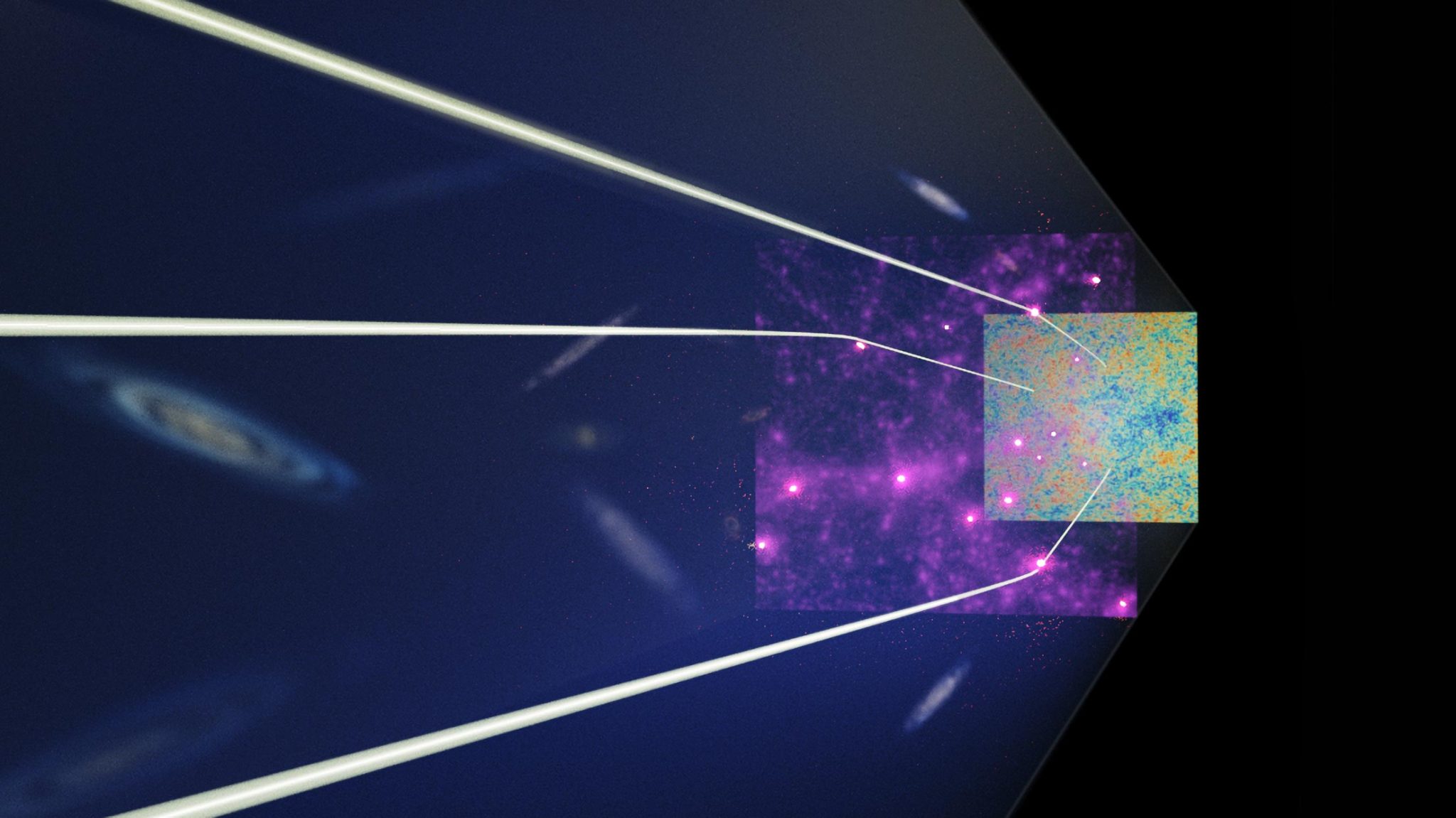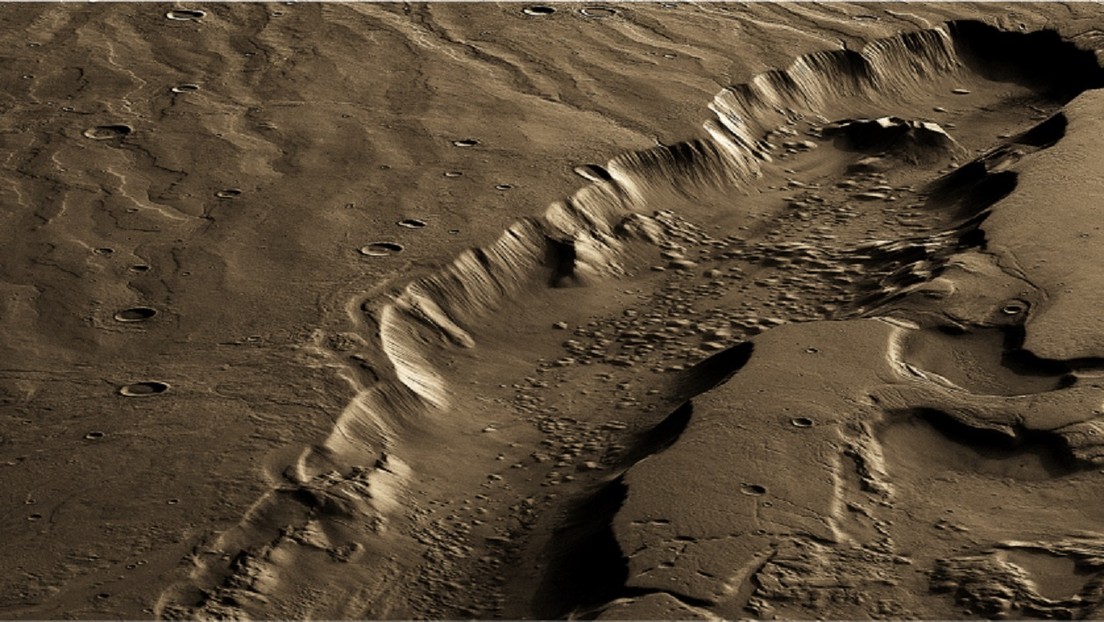Los astronautas de la NASA llegan para el primer vuelo espacial tripulado de Boeing
Horoscopo
Revelada la distribución de la materia oscura alrededor de las galaxias hace 12 mil millones de años

El residuo de radiación del Big Bang, distorsionado por la materia oscura hace 12 mil millones de años. Crédito: Reiko Matsushita
Los científicos han estudiado la naturaleza de la materia oscura que rodea a las galaxias tal como eran hace 12 000 millones de años, miles de millones de años más atrás que nunca. Sus hallazgos ofrecen la tentadora posibilidad de que las reglas fundamentales de la cosmología puedan diferir al examinar la historia antigua de nuestro universo. La colaboración fue dirigida por científicos de[{» attribute=»»>Nagoya University in Japan and the findings were published today (August 1) in the journal Physical Review Letters.
Seeing something that happened such a long time ago is challenging. Because of the speed of light is finite, we see distant galaxies not as they are today, but as they were billions of years ago. But even more difficult is observing dark matter, which does not emit light.
“It was a crazy idea. No one realized we could do this.” — Professor Masami Ouchi
Consider a distant source galaxy, even farther away than the target galaxy whose dark matter one wants to investigate. As predicted by Einstein’s theory of general relativity, the gravitational attraction of the foreground galaxy, including its dark matter, distorts the surrounding space and time. As the light from the source galaxy travels through this distortion in spacetime, it bends, changing the apparent shape of the galaxy. The greater the amount of dark matter, the greater the resulting distortion. Therefore, astronomers can measure the amount of dark matter around the foreground galaxy (the “lens” galaxy) from the distortion.
However, beyond a certain threshold, scientists encounter a problem. In the deepest reaches of the universe, the galaxies are incredibly faint. As a result, the farther away from Earth we look, the less effective the gravitational lensing technique becomes. Because the lensing distortion is subtle and difficult to detect in most cases, many background galaxies are needed to detect the signal.
Most previous studies have remained stuck at the same limits. Unable to detect enough distant source galaxies to measure the distortion, they could only analyze dark matter from no more than 8-10 billion years ago. These limitations left open the question of the distribution of dark matter between this time and 13.7 billion years ago, around the beginning of our universe.
To overcome these challenges and observe dark matter from the farthest reaches of the universe, a team of researchers led by Hironao Miyatake from Nagoya University, in collaboration with the University of Tokyo, the National Astronomical Observatory of Japan, and Princeton University, used a different source of background light, the microwaves released from the Big Bang itself.
First, using data from the observations of the Subaru Hyper Suprime-Cam Survey (HSC), the team identified 1.5 million lens galaxies using visible light, selected to be seen 12 billion years ago.
Next, to overcome the lack of galaxy light even farther away, they employed microwaves from the cosmic microwave background (CMB), the radiation residue from the Big Bang. Using microwaves observed by the European Space Agency’s Planck satellite, the team measured how the dark matter around the lens galaxies distorted the microwaves.
“Look at dark matter around distant galaxies?” asked Professor Masami Ouchi of the University of Tokyo, who made many of the observations. “It was a crazy idea. No one realized we could do this. But after I gave a talk about a large distant galaxy sample, Hironao came to me and said it may be possible to look at dark matter around these galaxies with the CMB.”
“Most researchers use source galaxies to measure dark matter distribution from the present to eight billion years ago,” added Assistant Professor Yuichi Harikane of the Institute for Cosmic Ray Research, University of Tokyo. “However, we could look further back into the past because we used the more distant CMB to measure dark matter. For the first time, we were measuring dark matter from almost the earliest moments of the universe.”
After a preliminary analysis, the scientists soon realized that they had a large enough sample to detect the distribution of dark matter. Combining the large distant galaxy sample and the lensing distortions in CMB, they detected dark matter even further back in time, from 12 billion years ago. This is only 1.7 billion years after the beginning of the universe, and thus these galaxies are seen soon after they first formed.
“I was happy that we opened a new window into that era,” Miyatake said. “12 billion years ago, things were very different. You see more galaxies that are in the process of formation than at the present; the first galaxy clusters are starting to form as well.” Galaxy clusters comprise 100-1000 galaxies bound by gravity with large amounts of dark matter.
“This result gives a very consistent picture of galaxies and their evolution, as well as the dark matter in and around galaxies, and how this picture evolves with time,” said Neta Bahcall, Eugene Higgins Professor of Astronomy, professor of astrophysical sciences, and director of undergraduate studies at Princeton University.
One of the most exciting discoveries from the study was related to the clumpiness of dark matter. According to the standard theory of cosmology, the Lambda-CDM model, subtle fluctuations in the CMB form pools of densely packed matter by attracting surrounding matter through gravity. This creates inhomogeneous clumps that form stars and galaxies in these dense regions. The group’s findings suggest that their clumpiness measurement was lower than predicted by the Lambda-CDM model.
Miyatake is enthusiastic about the possibilities. “Our finding is still uncertain,” he said. “But if it is true, it would suggest that the entire model is flawed as you go further back in time. This is exciting because if the result holds after the uncertainties are reduced, it could suggest an improvement of the model that may provide insight into the nature of dark matter itself.”
“At this point, we will try to get better data to see if the Lambda-CDM model is actually able to explain the observations that we have in the universe,” said Andrés Plazas Malagón, associate research scholar at Princeton University. “And the consequence may be that we need to revisit the assumptions that went into this model.”
“One of the strengths of looking at the universe using large-scale surveys, such as the ones used in this research, is that you can study everything that you see in the resulting images, from nearby asteroids in our solar system to the most distant galaxies from the early universe. You can use the same data to explore a lot of new questions,” said Michael Strauss, professor and chair of the Department of Astrophysical Sciences at Princeton University.
This study used data available from existing telescopes, including Planck and Subaru. The group has only reviewed a third of the Subaru Hyper Suprime-Cam Survey data. The next step will be to analyze the entire data set, which should allow for a more precise measurement of the dark matter distribution. In the future, the research team expects to use an advanced data set like the Vera C. Rubin Observatory’s Legacy Survey of Space and Time (LSST) to explore more of the earliest parts of space. “LSST will allow us to observe half the sky,” Harikane said. “I don’t see any reason we couldn’t see the dark matter distribution 13 billion years ago next.”
Reference: “First Identification of a CMB Lensing Signal Produced by 1.5 Million Galaxies at z~4: Constraints on Matter Density Fluctuations at High Redshift” by Hironao Miyatake, Yuichi Harikane, Masami Ouchi, Yoshiaki Ono, Nanaka Yamamoto, Atsushi J. Nishizawa, Neta Bahcall, Satoshi Miyazaki and Andrés A. Plazas Malagón, 1 August 2022, Physical Review Letters.
DOI: 10.1103/PhysRevLett.129.061301

Experiencia en periódicos nacionales y periódicos medianos, prensa local, periódicos estudiantiles, revistas especializadas, sitios web y blogs.
Horoscopo
El cuarteto copia el espacio en Clark para convertirse en el Centro de Aprendizaje Judío Jabad de Evanston
En algún momento antes de septiembre, el espacio de 2,300 pies cuadrados en 825 Clark St., anteriormente ocupado por Quartet Copies, probablemente volverá a estar lleno de actividad como el Centro de Aprendizaje Judío Jabad de Evanston.
En una llamada telefónica, el rabino Meir Hecht de Jabad de Evanston confirmó que Jabad compró el espacio a principios de 2024.
Espacio de aprendizaje y biblioteca abiertos al público.
Charles Davidson de Charles Davidson Group presentó la solicitud de análisis de zonificación en línea el 25 de febrero y la solicitud fue aprobada el 11 de marzo.
La solicitud incluía una carta de Hecht, como director de la Fundación de Aprendizaje Judío, que indicaba que el futuro centro de aprendizaje ofrecería clases para adultos diarias y nocturnas, una escuela hebrea para niños los domingos por la mañana, un salón después de la escuela para adolescentes, un salón después de la escuela. un programa de escuela de artes hebreas y una biblioteca abierta de domingo a jueves.
Actualmente, estas actividades se llevan a cabo en los hogares de las personas, en la Universidad Northwestern o en el Centro Comunitario Fleetwood-Jourdain. Hasta la pandemia, el programa de arte extraescolar se llevaba a cabo en las escuelas del Distrito 65. Hecht dijo que está ansioso por ponerlo en marcha nuevamente.
Los servicios de adoración se llevarían a cabo el viernes por la noche y el sábado por la mañana, así como durante los días festivos religiosos. Jabad Evanston ya cuenta con un espacio abierto y sin renovar para séders, almuerzos y servicios de Pesaj, dijo Hecht.
«Además, proporcionaremos a la comunidad una extensa biblioteca judía abierta al público para estudiar y leer», escribió Hecht. “La biblioteca y la sala de estudio/lectura serán un espacio acogedor para los miembros de la comunidad de todas las edades a diario.
“Esperamos que este nuevo centro de aprendizaje judío sea un faro de luz para toda la comunidad de Evanston. Todos son bienvenidos”, dijo Hecht.
En el sitio web de Quartet, la compañía ofreció la siguiente explicación sobre su salida en junio de 2023: “Actualmente estamos en el proceso de mudarnos de la ubicación de Evanston. Los propietarios están buscando un área comercial/industrial donde podamos continuar sirviendo a nuestros clientes de Chicago. En este momento busque imprentas locales.

Experiencia en periódicos nacionales y periódicos medianos, prensa local, periódicos estudiantiles, revistas especializadas, sitios web y blogs.
Horoscopo
Comparación de la tripulación comercial Boeing Starliner y SpaceX Dragon de la NASA

Uno de ellos ya ha transportado a ocho tripulaciones de la NASA y tres tripulaciones privadas a la Estación Espacial Internacional. El otro realizará su primer vuelo con tripulación la próxima semana.
Ambos pueden transportar hasta siete astronautas o una combinación de tripulación y carga. Ambos fueron diseñados para ser lanzados sobre cohetes y perseguir a la Estación Espacial Internacional, viajando a 17.500 mph (200-250 millas) sobre la Tierra, orbitando nuestro planeta cada 90 minutos. Chocamos contra el océano. Las otras “tierras blandas” del desierto.
El objetivo de ambas naves espaciales era encontrar una manera de proporcionar transporte a la ISS para los astronautas de la NASA, ahora que el transbordador espacial de vuelos largos había sido retirado. Ambos fueron seleccionados para recibir financiación pública en 2014 en virtud del contrato de tripulación comercial de la NASA.
Mientras Boeing se prepara para lanzar su cápsula Starliner en su primera misión tripulada a las 10:34 p.m. del 6 de mayo desde el Complejo de Lanzamiento 41 en la Estación Espacial de Cabo Cañaveral, esto es lo que necesita saber sobre Starliner y cómo se compara con SpaceX Dragon.
Boeing Starliner transportará astronautas de la NASA
Boeing lo llama el Transporte espacial de tripulación (CST) -100 Starliner, o simplemente “Starliner”. Su lanzamiento, cuyo lanzamiento está previsto para no antes del 6 de mayo, hará historia como la primera nave espacial en transportar humanos desde el Complejo de Lanzamiento Espacial 41. La plataforma ha sido el sitio de lanzamiento de misiones históricas que comenzaron con los cohetes Titán en 1965 e incluyeron el espacio profundo New Horizons. sonda, la nave espacial Voyager e incluso el rover Curiosity Mars.
Qué se lanza Dónde:Años después del retiro del transbordador espacial, Florida continúa con casi 70 lanzamientos al año
Recientemente se agregó al sitio un brazo de acceso para la tripulación en preparación para la prueba de vuelo con tripulación del Starliner, que se lanzará utilizando un cohete Atlas V ULA (una asociación entre Boeing y Lockheed Martin). El cohete Atlas V se lanza desde este lugar desde 2002, pero esta será la primera vez que llevará astronautas al espacio.
No te pierdas el próximo lanzamiento en Florida:¿Hay lanzamiento hoy? Próximo calendario de lanzamiento de cohetes para SpaceX, ULA y NASA en Florida
Boeing Starliner nombrado Calipso para esta misión
Como parte del Programa de tripulación comercial de la NASA, Boeing pretende que su Starliner transporte regularmente a astronautas de la NASA tras el éxito de esta próxima prueba de vuelo con tripulación. Una vez certificado por la NASA, Starliner se unirá al Dragon de SpaceX, que lleva tripulaciones de la NASA desde 2020. Boeing afirma actualmente que la NASA ha comprado seis misiones tripuladas adicionales más allá de esta próxima prueba de vuelo.
Según Boeing, una cápsula tripulada Starliner puede volar hasta 10 veces, con una vida útil de seis meses entre misiones.
La cápsula que voló el lunes recibió el nombre Calipso por la astronauta Sunita «Suni» Williams. En un guiño a su amor por el océano y la exploración, Williams dijo en 2019 que llamó a la cápsula Calipso después del barco Jacques Cousteau, quien fue un explorador oceánico a mediados del siglo XX. Este barco era conocido por su cámara de observación submarina y su equipo compuesto por un helicóptero y sumergibles, que ayudaban en las expediciones científicas. El comandante de la misión Butch Wilmore volará con Williams.
Boeing Starliner
apellido: Transporte espacial de tripulación (CST) -100 Starliner
Altura: 16,5 pies (cápsula + módulo de servicio)
Diámetro: 15 pies
Tamaño de la tripulación: Cuatro (puede transportar hasta siete)
Cohete: Lanzamiento en ULA Atlas V
Rampa de lanzamiento: Complejo de lanzamiento espacial 41
Reutilizabilidad de cohetes: vuelo único (ULA prueba la reutilización con Vulcan)
Destino: Órbita terrestre e ISS
Aterrizaje: Aterrizando en tierra bajo tres paracaídas y bolsas de aire en el suroeste de Estados Unidos.
Adjudicación del contrato de la NASA (2014): 4.800 millones de dólares
Boeing Starliner, primer atraque sin tripulación
El Starliner de Boeing se acopló con éxito a la Estación Espacial Internacional el 20 de mayo de 2022.
Dragón espacial X

apellido: Cápsula de la tripulación del dragón
Altura: 16 pies
Diámetro: 13 pies
Tamaño de la tripulación: Cuatro (puede transportar hasta siete)
Cohete: Lanzamientos en SpaceX Falcon 9
Rampa de lanzamiento: KSC 39A y Complejo de Lanzamiento Espacial 40.
Reutilizabilidad de cohetes: vuelos múltiples (Falcon 9 aterriza y vuela nuevamente)
Destino: Órbita terrestre e ISS
Aterrizaje: Se estrella en el océano bajo cuatro caídas principales después de usar dos paracaídas estabilizadores
Adjudicación del contrato de la NASA (2014): 3.100 millones de dólares
SpaceX Dragon, primer acoplamiento no tripulado
El SpaceX Dragon se acopló por primera vez a la Estación Espacial Internacional el 25 de mayo de 2012.
Brooke Edwards es reportera espacial de Florida Today. Contáctela en [email protected] o en X: @brookeofstars.

Experiencia en periódicos nacionales y periódicos medianos, prensa local, periódicos estudiantiles, revistas especializadas, sitios web y blogs.
Horoscopo
Los astronautas despegarán desde Cabo Cañaveral en su primer vuelo espacial tripulado en casi 56 años.

TAMPA, Fla. (WFLA) – Por primera vez en más de medio siglo, los astronautas despegarán de la estación espacial en Cabo Cañaveral, Florida, la próxima semana.
Si todo va según lo planeado, la nave espacial Boeing Starliner en un cohete Atlas V se lanzará desde Cabo Cañaveral, lo que será la primera vez que humanos despeguen desde la estación espacial en casi 56 años.
La última vez que se lanzó un ser humano al espacio desde Ciudad del Cabo fue a bordo del Apolo 7 en 1968.
Los dos astronautas de la NASA asignados al primer vuelo espacial tripulado de Boeing, Butch Wilmore y Suni Williams, llegaron a su sitio de lanzamiento la semana pasada, poco más de una semana antes de su despegue programado para el 6 de mayo.
Wilmore y Williams volaron desde Houston al Centro Espacial Kennedy el 25 de abril y servirán como pilotos de pruebas para la cápsula Starliner de Boeing, que hace su debut con tripulación después de años de retrasos.
El Starliner, que despegará el viernes sobre un cohete Atlas, volará a la Estación Espacial Internacional para un crucero de prueba de una semana. Boeing está tratando de alcanzar a SpaceX, que lanza astronautas para la NASA desde 2020.
En los dos vuelos de prueba anteriores del Starliner de Boeing no había nadie a bordo. El primero, en 2019, no he aprobado a la estación espacial debido a problemas de software y otros. boeing repetí la demostración en 2022. Más recientemente, la cápsula era presa por problemas con los paracaídas y cinta inflamable que hubo que retirar.
Wilmore enfatizó que se trataba de un vuelo de prueba destinado a descubrir todo lo que estaba mal.
“¿Esperamos que esto salga perfecto? Este es el primer vuelo humano de la nave espacial”, dijo a los periodistas. «Estoy seguro de que descubriremos cosas». Por eso hacemos esto.
Oficial de escuela de Florida arrestado después de que su hijo de 3 años se disparara
La NASA contrató a SpaceX y Boeing hace una década, pagándoles miles de millones de dólares para transportar astronautas hacia y desde la estación espacial. La agencia espacial todavía quiere tener dos cápsulas para sus astronautas, incluso si la estación espacial cerrará en 2030.
«Es de vital importancia», señaló Wilmore.
Wilmore y Williams serán los primeros astronautas en viajar en un cohete Atlas desde el Proyecto Mercurio de la NASA a principios de los años 1960.
La Prensa Asociada contribuyó a este informe.

Experiencia en periódicos nacionales y periódicos medianos, prensa local, periódicos estudiantiles, revistas especializadas, sitios web y blogs.
-
Horoscopo3 años ago
Horóscopo: ¿qué dice tu ascendente para hoy y el fin de semana del 27 de noviembre?
-
Entretenimiento2 años ago
¿Britney Spears y Sam Asghari están casados? Planes después de la conservación
-
Ciencia y tecnología3 años ago
Localizan la región de Marte más apropiada para la existencia de vida.
-
Negocios3 años ago
Reguladores federales investigan bolsas de aire en vehículos 30M
-
Deportes5 meses ago
Vista previa: Perú vs Brasil – predicciones, noticias del equipo, alineaciones
-
Horoscopo3 años ago
Paseo espacial estadounidense fuera de la Estación Espacial Internacional pospuesto debido a un problema médico con el astronauta
-
Entretenimiento3 años ago
Eva Longoria, Shonda Rhimes y Jurnee Smollett abandonan la junta de Time’s Up: «Listos para un nuevo liderazgo»
-
Deportes4 meses ago
Kyogo Furuhashi anota y Japón venció a El Salvador 6-0 en un amistoso | Noticias de futbol










